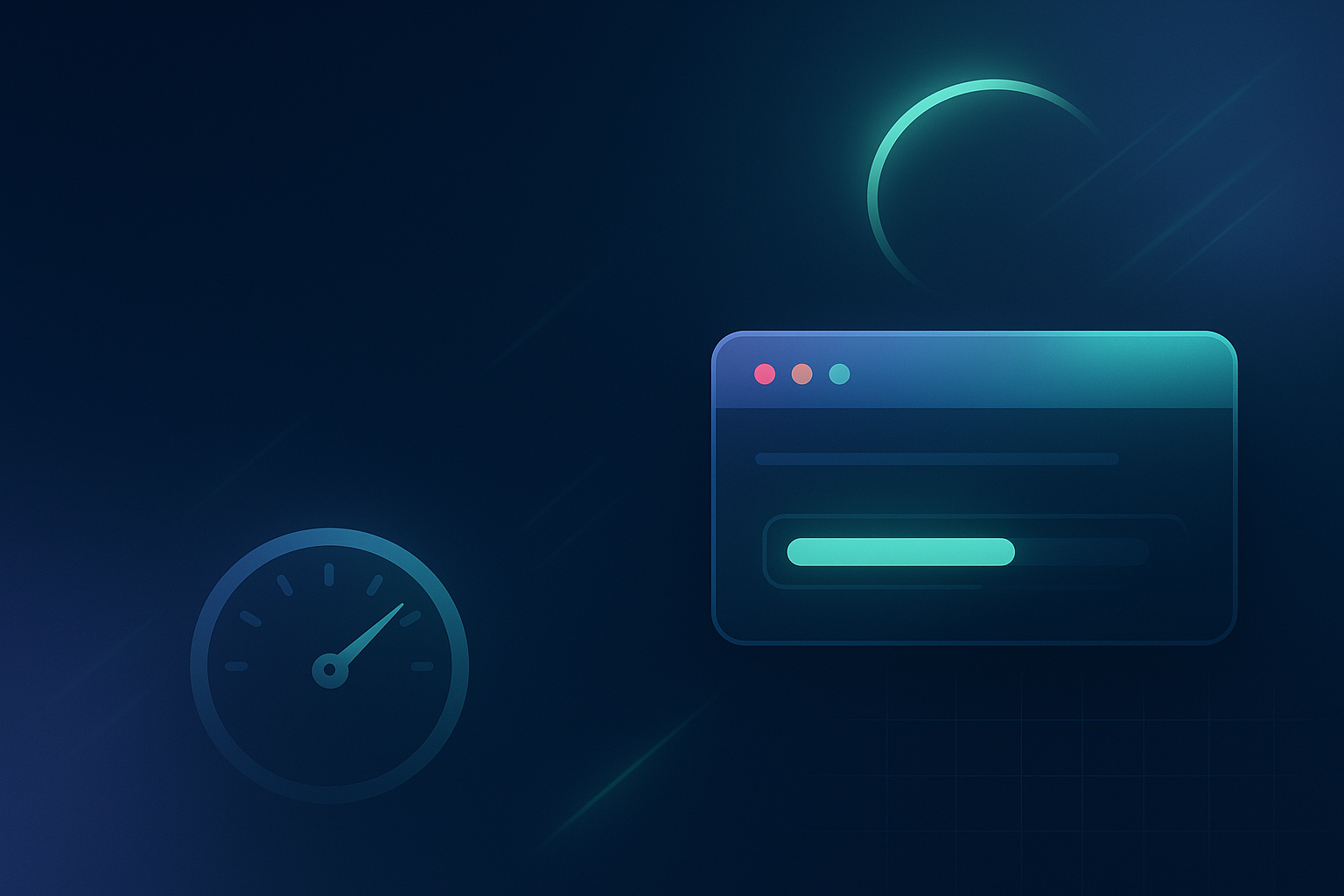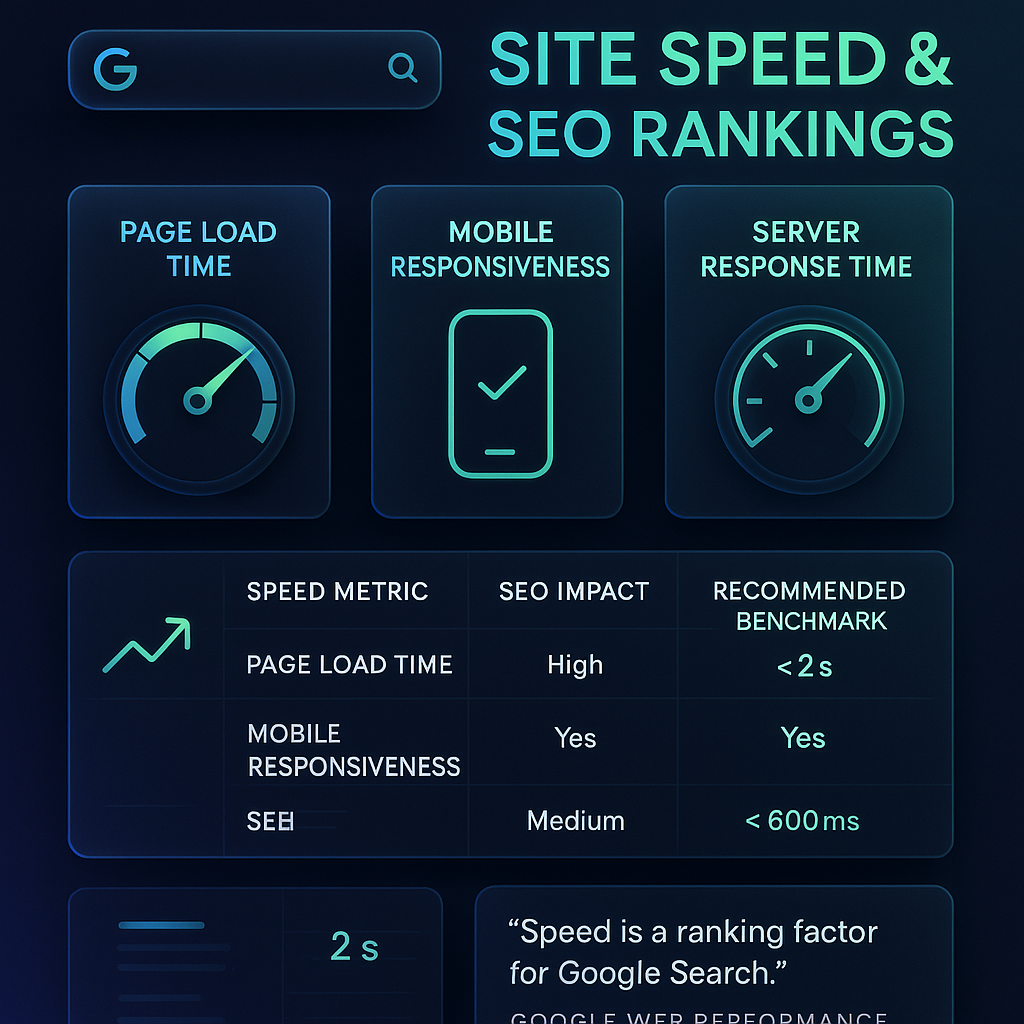
In today's digital world, website speed is key to success. Fast websites keep users happy, improve search rankings, and boost business. Every second matters in keeping visitors interested and turning them into customers. Users want websites to load fast. A slow site can lose you a sale in seconds. Whether it's an e-commerce site or a corporate page, speed is essential for a smooth online experience.
This guide will cover the importance of website speed. We'll look at how it affects user experience, search rankings, and your profits. You'll learn how to make slow sites fast and improve your online presence.
Key Takeaways
- Website speed directly influences user engagement and retention
- Slow loading times can significantly increase bounce rates
- Search engines prioritize fast websites in search rankings
- Mobile users are especially sensitive to website performance
- Website speed optimization is an ongoing process
Understanding Website Speed and Its Impact on User Experience
Website speed is more than just a technical metric—it's crucial for user experience. Today, users expect quick access to information. This makes page speed optimization key for businesses and website owners.
Modern internet users have very short attention spans. Research shows that a one-second delay in website loading can reduce page views by 11%. This highlights the need for fast website speeds to keep users engaged and prevent losing customers.
The Psychology of User Wait Time
User perception of website speed is deeply psychological. When a webpage loads slowly, visitors feel:
- Frustration and impatience
- Decreased trust in the website
- Higher likelihood of abandoning the page
"Speed is not just a feature. Speed is a feature." - Marissa Mayer, Former Google Executive
Mobile Users and Speed Expectations
Mobile users have high speed expectations. With over 50% of web traffic from mobile devices, fast page loading is crucial. Mobile users expect websites to load in 2-3 seconds, or they'll go to a competitor's site.
The Direct Connection Between Site Speed and SEO Rankings

Search engines like Google now see website speed as a key ranking factor. Fast websites get a big boost in search results. This makes website speed a key part of modern SEO.
Google's algorithm focuses on user experience, and website speed is at its heart. Quick websites get better rankings, which helps their online visibility and traffic.
"Speed is a killer feature. If your website is slow, you're losing visitors before they even see your content." - Google Web Performance Team
Important factors for website speed include:
- Mobile page load time
- First contentful paint duration
- Total blocking time
- Cumulative layout shift
Search engines check many speed metrics to judge a website's performance. Faster websites get better search positions. This makes speed optimization crucial for digital success.
| Speed Metric | Impact on SEO | Recommended Benchmark |
|---|---|---|
| Page Load Time | Direct Ranking Factor | Under 3 seconds |
| Mobile Responsiveness | Critical for Mobile Search | Fully Responsive Design |
| Server Response Time | Technical Performance Indicator | 200ms or Less |
Investing in website speed is no longer optional—it's a fundamental requirement for competitive digital presence.
How Website Speed Influences Conversion Rates and Sales
Website speed is more than just a technical detail. It's a key factor that affects a company's success. Making your website load faster is now a must for businesses wanting to increase online sales and keep customers engaged.
Today's online shoppers have little patience. A small delay in website speed can cost a lot of money. Studies show that even a tiny improvement in loading times can greatly increase sales across various industries.
Speed's Impact on E-commerce Success
E-commerce sites can see big changes by focusing on website speed. Here are some important points:
- 1-second delay can reduce conversion rates by up to 7%
- Sites loading within 2 seconds have substantially lower bounce rates
- Mobile users are particularly sensitive to loading times
Case Studies: Speed vs. Revenue
| Company | Speed Improvement | Revenue Impact |
|---|---|---|
| Amazon | 100ms reduction | 1% sales increase |
| Walmart | 1-second improvement | 2% conversion growth |
| Mozilla | 2.2 seconds faster | 15.4% more downloads |
Mobile Commerce and Loading Times
Mobile users expect websites to load quickly. Website speed is even more important for mobile shopping. If a site takes longer than 3 seconds to load, 53% of users will leave.
"Speed is not just a feature. Speed is the feature that can make or break your online business." - Web Performance Expert
Investing in making your website load faster is not just a good idea. It's essential for businesses that want to succeed online.
Common Factors That Slow Down Your Website
To make websites fast, we need to know what slows them down. Website speed is affected by many technical things. These can really hurt how users feel when they visit.
There are a few big things that make it hard to speed up websites:
- Unoptimized Images: Big, un-compressed images use a lot of bandwidth
- Too Many HTTP Requests: Lots of scripts and resources slow things down
- Complex JavaScript and CSS: Too much code makes pages take longer to load
- Server Performance: Weak hosting can slow things down
"Speed is not just a technical metric—it's a critical user experience factor." - Web Performance Experts
Big media files are a big problem for speed. High-quality images without compression can make pages load slowly. Web developers have to find a balance between looks and speed.
Too many plugins and scripts is another big issue. Each one needs its own server request, making pages load slower. Cutting down code and removing what's not needed is key for speed.
Fixing these problems needs careful technical work and ongoing effort to improve.
Essential Tools for Measuring Website Speed
Knowing how fast your website loads is key for better performance. The right tools help spot problems and show how fast your site is getting. These tools can make your site faster and improve its ranking on search engines.
Choosing the best tools for checking website speed is important. Experts use several tools to get a full picture of how well a site performs.
Google PageSpeed Insights
Google's free tool gives a detailed look at your website's speed. It shows how your site performs on mobile and desktop, and gives tips to make it better. Its main features are:
- Real-world performance data
- Detailed optimization suggestions
- Immediate performance scoring
GTmetrix and Alternative Testing Solutions
GTmetrix is a top tool for checking page speed, giving deep insights into performance. It's loved by experts for its detailed analysis.
| Tool | Key Features | Performance Focus |
|---|---|---|
| GTmetrix | Detailed performance graphs | Comprehensive website analysis |
| Pingdom | Global server testing | International performance |
| WebPageTest | Multiple browser simulation | Cross-platform evaluation |
Mobile Speed Testing Solutions
Mobile speed is crucial for today's websites. Special tools for mobile speed testing help ensure your site works well on all devices and networks.
"Speed is not just a feature—it's the foundation of excellent user experience." - Web Performance Expert
Using these top tools can help you make your site faster and more user-friendly.
Techniques for Optimizing Website Code
To make websites fast, you need to optimize the code. Start by cleaning up and making your website's code more efficient. Developers can make big improvements by using a few key methods.
Minifying code is a key strategy for better website performance. It removes extra characters, whitespace, and comments from files. This doesn't change how the files work.
- Remove unnecessary code comments
- Eliminate extra whitespace
- Compress file sizes
- Reduce overall script complexity
"Lean code is fast code" - Web Performance Experts
Asynchronous loading is another great way to speed up your website. It lets scripts load on their own. This stops render-blocking resources from slowing down the page.
Image Optimization Techniques for Faster Loading
Images are key to a website's speed. Slow images can make users unhappy and slow down your site. This can lead to a bad user experience.
Optimizing images is a smart way to make websites faster. Web developers can use smart image techniques to cut down page load times. This makes the site work better overall.
Modern Image Formats and Compression
New image formats like WebP and AVIF are great for speed. They compress images well without losing quality.
- WebP makes files up to 30% smaller than JPEG
- AVIF compresses even more
- Both support transparency and advanced color
Responsive Images Implementation
Responsive images make sure images fit the device. This cuts down on data and speeds up websites.
| Device Type | Recommended Image Size | Performance Impact |
|---|---|---|
| Mobile | 640x480 pixels | Up to 50% faster load |
| Tablet | 1024x768 pixels | Up to 40% faster load |
| Desktop | 1920x1080 pixels | Up to 30% faster load |
Lazy Loading Strategies
Lazy loading is a smart way to load images. It loads images only when they're seen by the user. This makes pages load faster.
"Lazy loading can reduce initial page weight by up to 75%, creating a smoother user experience." - Web Performance Experts
Using these image optimization techniques can make websites load faster. This leads to happier users and better rankings on search engines.
Server-Side Improvements for Better Performance
Website speed starts with the server. The right hosting can make a big difference. Not all servers are the same, and the backend is key for fast pages.
Improving server-side can make your site faster:
- Choose web hosting with solid-state drives (SSDs)
- Use advanced caching on the server
- Make database queries faster
- Use modern server protocols like HTTP/2 and HTTP/3
"The right server configuration can reduce load times by up to 50%." - Web Performance Experts
Optimizing your database is crucial for speed. Slow database queries can slow down your site. Use indexing, minimize queries, and add caching layers to speed up servers.
New server techs help a lot with speed. HTTP/2 and HTTP/3 send data faster, cutting down on wait times. They let servers handle many requests at once, making data exchange smoother.
Cloud hosting from Amazon Web Services and Google Cloud is great. They offer scalable solutions that adjust to traffic. You get advanced caching, CDNs, and auto-performance boosts.
- Implement server-side caching strategies
- Use content delivery networks (CDNs)
- Enable compression technologies
- Monitor and analyze server performance regularly
Improving server-side is more than just speed. It's about making your site fast and user-friendly. This keeps visitors happy and engaged.
Implementing Browser Caching and CDN Solutions
To make websites load faster, we need smart page speed optimization. Browser caching and Content Delivery Networks (CDNs) are key. They cut down loading times and boost user experience.
Browser caching makes websites quicker by saving site resources on your device. When you come back, your browser uses these saved resources instead of downloading them again.
Cache Configuration Best Practices
Setting the right cache times is crucial. Here's how:
- Static files like images: Set longer cache durations (1 year)
- CSS and JavaScript: Moderate cache periods (1 month)
- Dynamic content: Shorter cache times (1 hour)
Choosing the Right CDN Provider
When picking a CDN, look at these important points:
- Global server network coverage
- Performance metrics and speed tests
- Pricing structure
- Security features
"Speed is not just a feature, it's the foundation of modern web experience." - Web Performance Expert
Using browser caching and CDNs can greatly improve your website. It makes your site load faster and keeps users happy.
Mobile-First Speed Optimization Strategies
Mobile devices are now the main way people access the internet. This makes website speed very important. Fast websites are not just nice to have; they're essential for keeping mobile users happy and engaged.
To make websites fast on mobile, businesses need a smart plan. They must think about a few important things to make mobile browsing smooth:
- Minimize network payload for slower mobile connections
- Implement responsive design principles
- Prioritize touch interaction performance
- Utilize Accelerated Mobile Pages (AMP) technology
"Speed is the new currency of business" - Marc Benioff
Mobile users hate waiting for websites to load. Studies show that 53% of mobile users leave if a site takes more than three seconds to load. This highlights the need for fast website speeds to keep users interested and reduce bounce rates.
Here are some key ways to make websites load quickly on mobile:
- Compress and optimize images
- Leverage browser caching
- Minify CSS and JavaScript
- Use content delivery networks (CDNs)
By focusing on making websites fast for mobile, businesses can offer better digital experiences. This keeps users happy and helps drive sales.
Conclusion
Website speed optimization is key for digital success. We've covered many ways to boost your website's speed and user experience. You now have tools to make your online presence better.
Studies show that fast websites get more visitors and rank higher in search results. They also convert better. So, making your website faster is essential for online businesses.
By using image compression, code optimization, and efficient servers, you can make your site much faster. This will improve how well it works.
Page speed optimization is a continuous effort. New technologies and higher user expectations mean you need to keep up. Start with small changes and use tools like Google PageSpeed Insights to track your progress.
Your website is often the first thing people see of your brand. Make a great first impression with a fast, smooth, and responsive site. This will keep visitors interested and coming back.

Custom video production at scale
Aneeverse covers all video needs whether you're telling your brand story, launching a product or running ads. Discover how we can help you scale.
